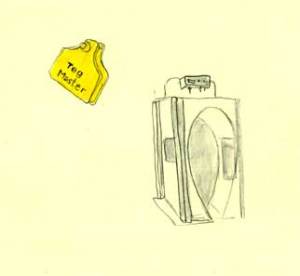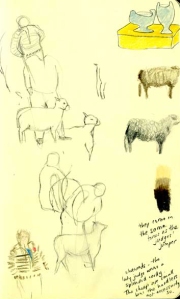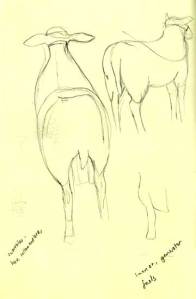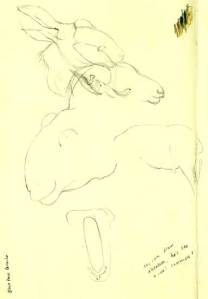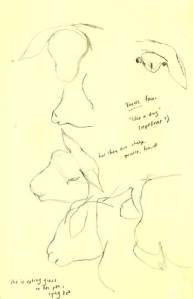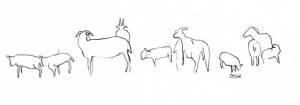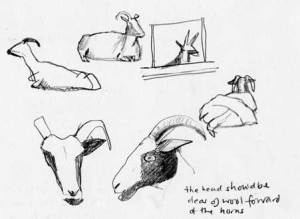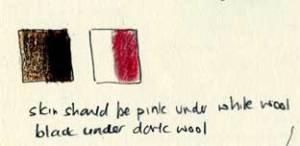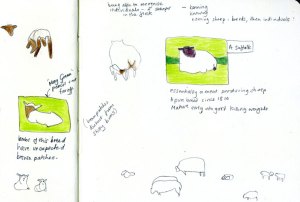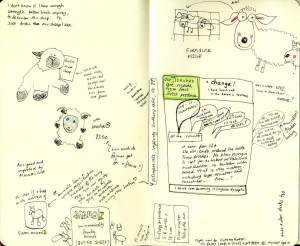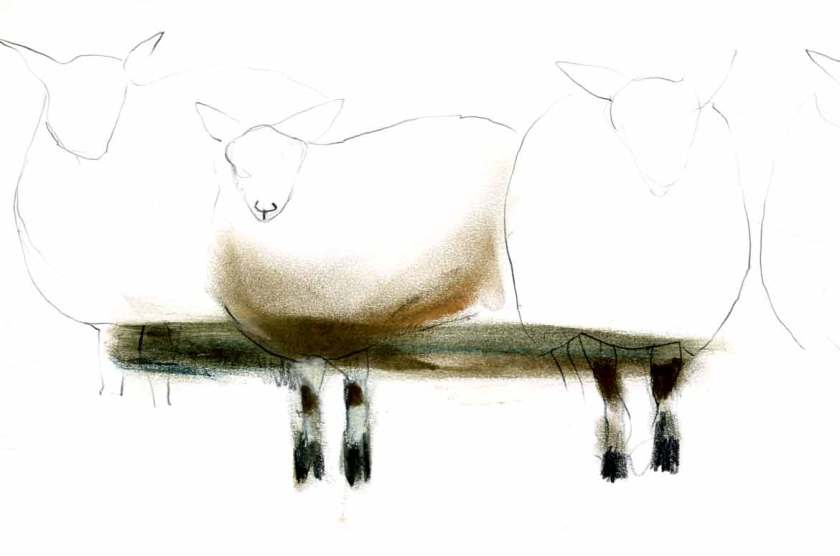Tagmaster is a company supplying equipment to read the EID tags in sheeps ears as they pass through pearly gates – now being used at marts and slaughterhouses. Copper antenna loop over them, concealed within white plastic. The gate’s design is light with windows, making it less intimidating for the animals.
Category: singularity
One sheep in a field is not like the next, but it takes a cultivated eye to see how they differ. Humans have bred sheep to the shapes they take, but also sheep supply their selves to the situation. Humans may choose to see this, or not. In any event, farmers now are obliged to equip sheep with unique identifiers to trace them wherever they may go.
tracking wool, and sheep too
Scottish tweeds are today fashioned from global wool – one of the routes is slow boat from New Zealand to Turkey where it is spun and dyed, and transported by lorry to a Scottish mill.
Another aspect of globalisation is beign raised in a forthcoming seminar (Aug 31, 2010) in Queensland University of Technology, by Dr Anne Galloway, Victoria University of Wellington- to quote (my emphasis):
Counting Sheep: New Zealand Merino Wool in an Internet of Things
Abstract: “Pervasive computing brings together wireless, networked and context-aware technologies, including Global Positioning System (GPS), environmental sensors and Radio-Frequency Identification (RFID), to embed computational capacities in the objects and environments that surround us. The ‘Internet of Things’ is a related vision for future computing that proposes a shift from a network of interconnected computers to a network of interconnected objects. By virtue of their status as highly regulated and globally traded commodities, livestock animals and animal products have long been tracked and are primed to be amongst the first non-humans in such a network. Specifically, RFID-enabled livestock traceability programmes are increasingly being mandated by governments and agricultural industries worldwide to better support management of disease outbreaks and maintain access to high-value export markets. In these technologically determinist traceability scenarios, animals are largely envisioned as manageable and saleable information and farmers are more often positioned as technicians and data collectors than as animal caregivers.
Dr Galloway’s project investigates the role that cultural studies and design can play in presenting both producers and consumers with alternate visions for the future of human-animal relations. Through a juxtaposition of technological livestock management programmes and non-technological wool industry products and services, this presentation will critically question the social and cultural implications of emergent technologies and existing traceability efforts. Particular attention will be given to articulating research practices and stakeholder relations that can significantly engage relevant issues and avoid the pitfalls of both dystopian and utopian futurism.
Link: <http://www.purselipsquarejaw.org/>
mountain sheep and man
Mountain Sheep and Man in the Northern Wilds by Valerius Geist. 1975. Blackburn Press, New Jersey.
An ethological account of wild mountain sheep, in the Rocky Mountains. Valerius Geist is not afraid to link his scientific insights to his own developing maturity, nor to make parallels between how sheep and humans behave, for example in combat. He was taken aback to find that mountain goats would kill each other if they could, and reasons that mountain sheep are protected from damaging each other by their physiology. He observed how rams established hierarchy, and again was taken aback to elicit homosexual behaviour between subordinate and dominant males. I can’t judge his scientific work – for example on cold climates as an evolutionary prompt for humankind holds water – but enjoyed his writing style and his insistence on linking how animals are to how we are, and what we do. In the final chapters he describes encounters with tamed mountain sheep – acknowledging his initial naivety believing that he had successfully disguised himself as a goat. “I could have changed my “goat suit” for that of a circus clown with equal effect.’ p228). The sheep knew what he was all along but would be tamed for the salt that they craved in early spring.
“Thus when I arrived in Banff National Park after my Stone’s sheep study, groups of enthusiastic amateurs had long known somehting that professional zoologists were not quite conscious of: namely, that wild, unhunted animals can get along with man in a fashion reminiscent of the Biblical paradise.”
“Have you ever sat on a mountainside and observed a ram graze below you, watched the ram finish feeding, then look up and come to you, paw a bed that sedns the dust and pebbles striking your legs, and then lie down beside you? There you sit, the cunning hunter and the cunning prey, while the wind plays genlty with your hair, and is heavy eyes blink, ready for a little nap. The clouds move past overhead adn their shadows play in the valley, the grasses rustle in the breeze, and the eagle soad past along the slope below both of you. The creature resting beside you is as free and wild as the mountains that nourish it. It can choose to leave yo, but it does not. For the moment, it prefers your company.”
He gained insights as a result: “some of my concerns were rather mundane, such as checking if chronological age, as determined from dates of tagging, did coincide with age rings on the horns. It did. I could demonstrate to my satisfaction that the sheep were exceedingly loyal to their seasonal home ranges and reappeated at the same seasons each year in the very same places. I could show .. that rams moved between the female groups. Thus the female sheep in a group were largely related by maternal descent. The scientific discoveries pale, however, beside the recollection of the individuals I came to know for a few years of their short lifves. Some were shy individuals who waited a logn time before they decided to come to me. … Others, in particular the females, became exceedingly tame, and stuck their noses into everything – my pockets, my rucksack, my camera lenses, and even my cameras if I had to change film… (p221)”
In concluding paragraphs, when he leaves the mountains, he asks “Think of the carbon, nitrogen and water cycles. Is there not poetry, no art, no philosophy in them? have they no dimensions beyond the scientific ones? Do they not say something about the stuff that forms me, which the I gave shape to. They say that the me has been eternal and will be so, whichever way we define eternal. … Me cycles and recycles; I comes and I goes. Me is my link to eternity; I to the present. I is my link to mysteries past and mysteries future. The land is in me and of me….”
Border Union Show Interbreed Championship, 2010
A Cheviot Gimmer won the day, with a Blackface Ram in second place. There were many contenders.
Shetlands: the sheep come in the same tones as the judge’s jumper.
Small enough you can pick them up. Submission and sleep, rumination.
Zwartbles: have collars and leads.
Blue-faced Leicester: the ram draws attention. “Like a cow! enormous!”
Texels: She is eating grass, lying down, gentle, timid. “They look like a dog!”
sheep breeds / Jacobs
I take a closer look at Jessie Jacob and her relatives
Using Jacob Sheep Society breeding Standard notes, I start to see them as a carefully cultivated product. What does ‘upstanding’ mean in a sheep?
“the head should be clear of wool forward of the horns”
“Mottled skin and wool is undesirable”
Well, I think she is lovely …
Finally she comes to have a look at me – and pisses

